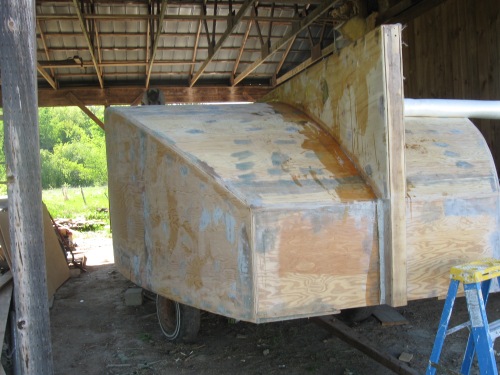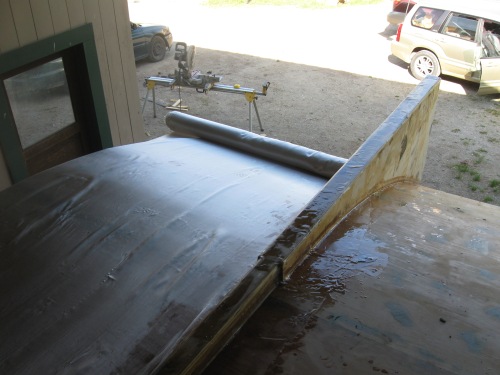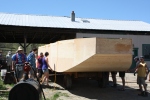Glassy
A long time ago I worked in what you might call a fiberglass tree factory. Not making Christmas trees, but everything except Christmas trees. A ridiculous assignment in pretty nasty conditions and although I got a lot of good stories out of the experience I won’t dwell on it here, except to note that I am pretty well seasoned in fiberglass work as a result of it. Fiberglass is not terribly fun to work with but my goodness, you can make a lot of watertight integrity in a small space of time if you know how to manage it. And if you don’t, it’s a fairly plastic medium. All mistakes are correctable, some more easily correctable than others.
Now that our hull is inverted we have puttied all the gaps and screw holes with short-strand polyester-based body filler and sanded down to 80 grit. New recruit Brian and I began laying glass in Epoxy resin on Saturday. It went fairly well, covering about 25% of the boat in maybe 3 hours. If all goes well we should be glassed from stem to stern and painted by the end of the week. Then we will right the hull again, build decks, hatches and doghouses and then proceed to rigging.
I am very excited about the rigging aspect. Rigging specialists Carrie and Will Glesner have been providing invaluable help in this regard, and from the deck up Ceres will be rigged with traditional materials and principles, using hemp rope, canvas and tar. We can make the blocks and belaying furniture with wood cut largely from our own farm. As traditional a task as our current task is synthetic.
There is still a lot of work ahead but a launch by July 4th seems within reach!
A while back when a reporter was interviewing me about the project she asked, “what are you thinking about when you work on your boat?” My answer: “What I’ll do different when we build the next one.” A little bit of a flippant response, sure, but also somewhat accurate. If this idea is good enough for one barge it’s good enough for ten. If this concept takes off like I hope it will we may at some point not be able to build the sailing barges fast enough.
Are we at VSFP the only ones loopy enough to believe in a future powered by the wind? Not in the least. Let me introduce new friends at Dragonfly Sail Transport Co. With a suitable vessel for small scale trade in the Great Lakes already in possession and a plan to begin moving cargo for local merchants, Jan Barlow and company are now raising funds to launch their venture on Start Some Good. Check out their project at Start Some Good
and help spread the word about the return of working sail. I can say with utmost certainty that we need more practitioners in this field. Salish Sea Trading Coop in Washington State was friendly and collegial with our project from the start and helped convince us Vermonters it could all be done. We owe Salish and Kathy Pelish a lot, and we will pay that forward wherever we can to help others like Dragonfly succeed. We all need sustained interest to create and expand this movement. Crowdsourcing is one way to help make that happen. It worked for us, and we hope it will work to help our fellow Sail Transport Network








